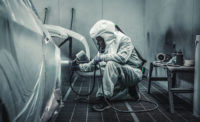Today, most chemicals can be sampled easily, without having to use pumps, cartridges or filters. The passive badge dosimeter allows even non-experienced personnel to obtain exposure readings.
The first American patent for a colorimetric tube was issued in 1919 for the detection of carbon monoxide1. Further research into the use of adsorptive passive dosimeters began in 1973 for the sampling of nitrogen dioxide2 and has expanded to what is available today. These units include small badges, color changing diffusion tubes and chemical treated papers3.
Passive sampling
Passive sampling is defined as the collection of airborne gases and vapors at a rate controlled by a physical process such as diffusion through a static air layer or permeation through a membrane without the active movement of air through an air sampler4. Or in other words, there is no pump to pull or push gas over an adsorbent or absorbent material.It is this diffusion of contaminated molecules, moving from an area of high concentration to an area of low concentration on the sampler3, that enables this type of sampler to function.
Advantages and disadvantages of using passive samplings include:
Advantages
- Easy to use;
- Requires minimal training;
- Economical — no costly pumps or sampling equipment is required;
- Less burdensome to worker — only a lightweight badge or tube is worn;
- Samplers are available that can be used for both short- and long-term sampling.
Disadvantages
- No means to measure the air flow. Manufacturer should supply a validation report to the user;
- Theoretical uptake rate may not prove valid under conditions of use;
- Few analytical methods have been published by governmental agencies;
- No indication of breakthrough or reverse diffusion;
- Affected by environmental factors such as wind velocity, temperature and humidity3;
- Sampling is either not accurate enough or not approved for compliance sampling.
Badge-type passive samplers
After deciding what chemical(s) you need to sample, select a manufacturer that offers a passive sampler that can be analyzed for those chemicals. Follow the manufacturer’s instructions in assembling the badge. Record the employee’s name, other pertinent information and the start time. After the recommended sampling time, usually eight hours, cap the sampler and record the finish time. Send the badges to the laboratory with the necessary information and await the results.Colorimetric diffusion samplers
A colorimetric tube is also known as a "length of stain" tube, due to the fact that the concentration of the chemical being tested produces a color stain in the analytical material — the stain length being proportional to the concentration in the air.The operation is relatively simple. Once a tube is selected for the chemical to be measured, the ends are broken off the tube using the tool provided. The tube is inserted into the pump housing and the pump is either squeezed a specific number of times or the handle is pulled on the piston a specific number of times. If the chemical is present, the material inside the tube changes color and the length of the color stain is read against the scale on the tube to give the concentration.
Results can usually be obtained in as little as 30 seconds, depending on the number of squeezes or strokes required. Acetic acid needs only three strokes to get an answer within 30 seconds, while vinyl chloride requires upwards of 20 strokes that could take eight minutes5.
Colorimetric tubes are also available for both short- and long-term sampling, meaning upwards of eight hours. Sampling is accomplished with the use of a special constant flow pump, similar in function to that required for active sampling.
Advantages and disadvantages with colorimetric tubes include:
Advantages
- Simple to use;
- Real-time results;
- No laboratory analysis required;
- Relatively quick response;
- Wide range of chemical tubes available;
- Portable.
Disadvantages
- Tolerances on the accuracy can be very high, in some cases +/- 25 percent to 30 percent;
- Tubes must be stored under appropriate conditions and used before their expiration date;
- The person performing the sampling may need special PPE as protection in the unmeasured environment;
- Temperature and humidity can affect the chemical reaction inside the tube;
- Some tubes will cross-react with other chemicals giving a false reading.
The right tool?
If you require compliance samples, I would recommend contracting a competent industrial hygienist to perform the work. However, if all you need is an indication of the extent of the exposure so that further studies can be developed, then passive dosimeters may be the right tool to use.REFERENCES
1Drager Safety AG & Co. KgaA, Drager-Tubes/CMS-Handbook, 12th Edition, Germany, 2001, p. 212 DiNardi, Salvatore R., editor, The Occupational Environment — Its Evaluation and Control, American Industrial Hygiene Association, Fairfax, Va., 1997, p. 8
3 Dietrich, Deborah F., AIHA Review Course on Air Sampling presentation outline, 2003
4 DiNardi, op. cit., p. 1320
5 Drager, op. cit., pp. 60 and 229
